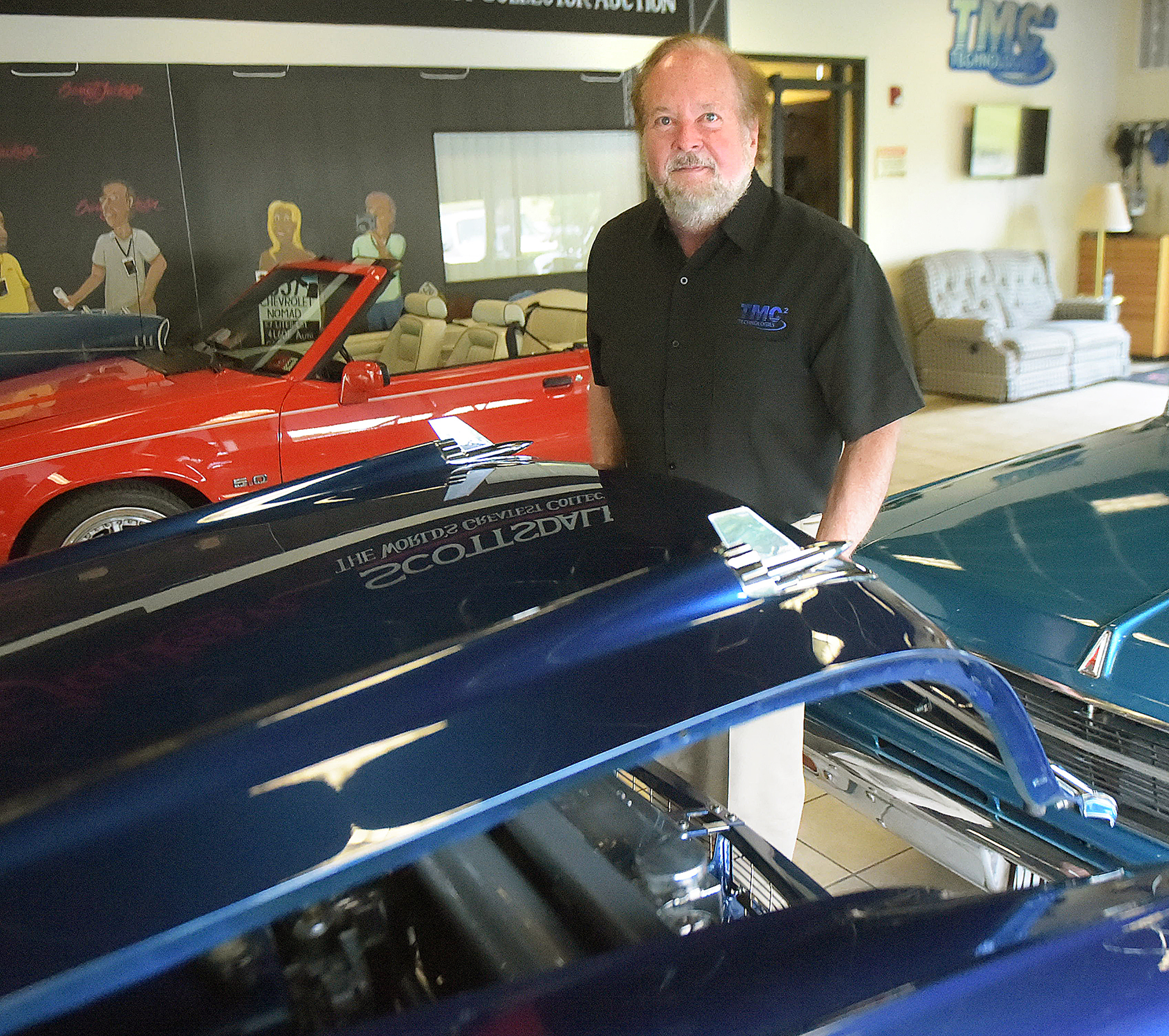FAIRMONT – If you want to hear about that $24 million NASA contract, you have to take the car tour, first.
One look at rocket ship-styled hood ornaments and other trappings on that 1957 Chevrolet Nomad told the tale in Wade Linger’s garage Wednesday afternoon.
The Chevy Nomad was a station wagon – of all things – a perfect visual for Eisenhower’s America.
However, even if it was solid and comfortable, it was still accessorized with that American predilection, and that American fascination, of simply soaring faster and higher than everyone else.
There was dashboard, with its jet fighter instrumentation.
And that whiz-bang steering wheel, smacking of test pilot bliss.
Those aerodynamic tail fins, too.
Don’t forget the chrome-laden, backup lights, bearing an on-purpose resemblance to the thrusters on a rocket ship to Mars.
“That’s where we were then,” Linger said.
Tailfin ’57 was also the year the Russians got to outer space first – when Sputnik when up.
While the humble satellite didn’t do much but omit radio beeps while making a few low-orbit passes around the Earth, it launched the Space Race that eventually put Neil Armstrong and Buzz Aldrin on the Moon.
“And he we are now,” Linger said, popping the Nomad’s hood to show its 21st century workings underneath.
Lest you think, though, this story is solely about classic cars … well, it isn’t.

Riding shotgun
In car circles, Linger is known as the owner and proprietor of Wade’s Garage, which dresses up classic, Detroit rolling iron with the newest of the new technologies: Brakes, suspension, torque and the like.
But that’s not his main job.
He’s also the president and CEO of TMC Technologies of West Virginia, which is within walking distance of his auto business.
TMC is a high-tech concern in Marion County that just landed that aforementioned, five-year contract with the space agency.
From its offices and labs in Pleasant Valley, near Fairmont, Linger’s company will take that contract and continue what it has already been doing for NASA’s Katherine Johnson Independent Verification and Validation (IV&V) facility in Fairmont’s I-79 Technology Park.
The IV&V facility, and Linger’s company, test out the software and hardware systems that make launches and space exploration go.
It was born out of catastrophic failure. NASA’s IV&V effort was in response to the Challenger space shuttle disaster in 1986.
“This is pretty significant work,” Linger said. “We’re honored to be part of it.”
He’s honored by the West Virginia interstellar connections, too.
Three years ago, the IV&V facility was renamed in honor of Johnson, the elite mathematician from Greenbrier County who figured key coordinates for the early Mercury missions and the Apollo 11 moon landing, also.
Linger is also a West Virginian. He grew up in Charleston and learned how to be a computer programmer in the U.S. Air Force. Cars entered his orbit later.
He came to Fairmont in 1992 as a defense contractor and remembers the IV&V ribbon-cutting when the earth was first moved along the highway in South Fairmont.
“It was a cow pasture,” he said.
Punching it
Wednesday, the work was lifting off at both of Linger’s operations.
In the garage, mechanics were outfitting a ’64 Ford Fairlane with space-age brakes and suspension – to go with that high-performing engine that was just dropped in.
On the TMC side, senior systems engineer Steve Yokum was huddling with Gary Carvell and other members of his team who were talking about vessels that don’t need four wheels and road.
Yokum, for example, is overseeing the assurance side of the science fiction-sounding X-57, NASA’s first all-electric experimental airplane.
TMC also engineered West Virginia’s first satellite, the STF-1 – Simulation to Flight 1 – which is way outperforming Sputnik, as it is still orbiting after two years, when the original projections were three months.
There’s also the company support work with NASA’s Artemis Project, which aims to colonize the Moon and craft a launch pad – for a manned mission to Mars.
Ask Randy Hefner about it, and he’ll tell you the work is groovier than a set of Cragar mags on your great-grandma’s Buick Riviera.
Hefner hails from Weston. He’s a WVU computer science graduate and TMC’s chief technology officer and vice president.
Like Linger, Hefner touched back down in the Mountain State after doing software engineering work on life-support systems in the International Space Station and numerous other NASA projects.
Such work, he said, requires the deployment of a grim, crystal ball of sorts.
Every disaster, every worst-case contingency has to be reverse-engineered, Hefner said.
Call it the equivalent of building a roller coaster ride, then immediately knocking it down, to see what stayed attached, and what didn’t.
When one can take binary code – the ones and zeros of the programming language, he said – and make it “talk” mission success, there’s nothing better.
“That’s when it gets really cool,” he said, grinning.
TWEET @DominionPostWV




